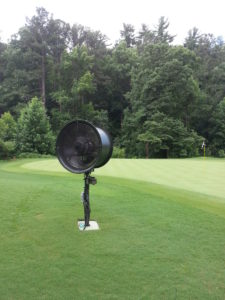By Kevin Sams
It is the goal of the Big Canoe Golf Course Maintenance Department to continually provide golfing members with the best possible playing conditions on a daily basis, year-round. Each season of the year provides different challenges to meeting this goal, therefore the cultural practices and the tools used must change as well.
These big blades will help keep our bentgrass blades, and you, cool. (Photo by Lydell Mack)
The bentgrass grown on our putting greens is known as a “cool-season” plant. Simply put, this means it is genetically suited for optimum growth at temperatures around 65ºF. This is why it grows actively throughout our cooler seasons in Georgia, providing our members a year-round attractive putting surface.
However, the summer months can be incredibly stressful for bentgrass because it does not possess the ability to cool itself (through transpiration) beyond an air temperature of 85°F. Professional research has shown that as temperatures climb to that threshold, the plant functions of photosynthesis and respiration slow to a halt, at which point the plants begin to wilt, thin out, and ultimately die. This heat injury that occurs is exacerbated by high humidity and other stresses like low-mowing, foot traffic, fungus, and drought.
The most reliable method of combating the potentially devastating environmental conditions of heat and humidity is constant air flow across the turf canopy’s surface. Since a constant natural wind is not reliable or predictable, the use of electric fans has become an essential tool for maintaining bentgrass greens in Georgia. Multiple studies have shown that 24 hrs/day air flow when the soil temperature is above 75ºF is the optimum practice for increasing the plant’s natural cooling process. Field observations from other superintendents over many years and my personal experience have shown this to be true.
The fans chosen for operation at Big Canoe are the smallest and quietest models available for our application. The fan location at each green site has been chosen based on manufacturer recommendations which take into consideration green size, elevation and orientation, direction of play, and prevailing wind direction. The fans run constantly when soil temperatures are constantly above 75ºF, which is generally from early June to early September in our region.
Any reduction in operating hours increases the risk of declining playing conditions and ultimately a complete loss of the playing surface. Greens’ reestablishment will cost tens of thousands of dollars plus loss of revenue. Given these risks, golf course maintenance procedures are to operate the fans based on minimizing risk during the vulnerable months of June, July, and August.
The post Using fans to cool our golf courses appeared first on Inside the Gates.
